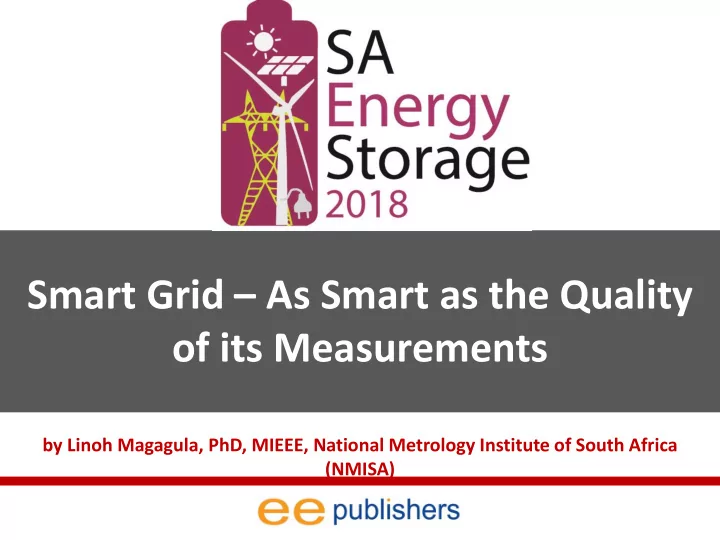

Smart Grid – As Smart as the Quality of its Measurements by Linoh Magagula, PhD, MIEEE, National Metrology Institute of South Africa (NMISA)
Smart: communication; sensing; control • Smart grid – intelligently integrated electricity network to efficiently deliver sustainable, economic and secure electricity supplies Improved power quality
• Quality measurements … – Accurate , precise, traceable . • Quality measurements are necessary to ensure good functioning of such a network – Renewables are intermittent & vulnerable to instability – Can inevitably impact stability of main network if not accurately managed – Quality measurements facilitate good monitoring & controllability
• Very brief background … national quality infrastructure & metrology • Metrology covers depths of knowledge that are familiar only to a few – but everyone makes use of
• National Quality Infrastructure: system needed by business and governments to optimise production, protect consumer rights, health, environment, security, trade and provision for adequate quality of service – Metrology is pivotal • Science of measurement and its application • Vital part of our everyday life – Coffee bought by weight – Water, electricity are metered – Police speed traps, surgeon’s laser, hours of sunshine, room temperature, etc. • Science & engineering completely dependent on measurement
• Metrology includes all practical and theoretical aspects of measurement & is divided into 3 overlapping activities: – Definition of internationally accepted units of measurement (e.g. ampere - The ampere is that constant current which, if maintained in two straight parallel conductors of infinite length, of negligible circular cross-section, and placed 1 metre apart in vacuum, would produce between these conductors a force equal to 2 x 10 – 7 newton per metre of length. ) – Realisation of these units in practice by scientific methods – Traceability (i.e. linking measurements to reference standards: reliable, trusted and accepted internationally)
Quality Infrastructure • Metrology , standardisation , conformity assessment and accreditation form independent pillars of essential quality infrastructure – national and international
• In South Africa, we refer to the national quality system as Technical infrastructure
• Electricity supply industry is evolving – Prosumers (consumers also producers) → trade – Energy savings & energy efficiency very important – Innovative storage , 2-way comms, integration of different sources, etc. → Accurate & traceable measurements become crucial • Facilitate seamless integration of different energy sources (conformance to grid code) • Facilitate precise monitoring & control of state of the grid • Quality & safety • Support technological innovation • Prevent conflicts in trade, billing, etc.
Accuracy & Traceability • Accuracy : A measurement is accurate if the average of a set of repeated measurements is close to the true value of the quantity being measured • How can we be sure that measuring instruments/devices can accurately measure? – Acceptable method to ensure accuracy → calibration (measuring the instrument against a measurement standard, which is of higher accuracy) – determines performance characteristics of the instrument Voltage & resistance standards are basic references from which all digital voltmeters & calibrators derive accuracy
• Traceability : The value of the calibration standard must be related to stated references, i.e., national standards through an unbroken chain of transfer comparisons, all having stated uncertainties originating at a national standards laboratory
• Accuracy of national standards validated through international comparisons
Which measurement reading is correct? 87 MWh 132 MWh • Specifications of new measuring instruments are usually valid for 2 – 3 years – Only through traceable calibration can accuracy of measurements be validated
Power quality issues • Renewable & alternative energy sources can potentially degrade the power quality of the supply from the grid – Cause losses, malfunctioning of equipment, power outages, etc. • Improving monitoring can alleviate situation – Requires reliable (accurate & traceable) measurements to enable precise controllability: (the more accurately measured the more the process can be optimised) • Harmonics, Flicker, Power frequency, ROCOF, Voltage dips & swells, etc.
• The IEC 61000 – 4 – 30 power quality measurement method standard depends on traceable measurements to achieve its goals – “all instruments will, when connected to the same signal, produce the same result” • Calibration of measuring instruments to traceable measurement standards is the only method that can ensure accuracy of measurements – Power quality measurements are important to system operators to ensure that a connected plant does not cause undue disturbance to their network
• Example aspects requiring accurate measurements in smart grids: • Smart grid – as smart as the quality of its measurements – Accurate measurements improve quality (of life)
Take away… • 4 main reasons for having an instrument calibrated – To establish & demonstrate traceability – To ensure readings from the instrument are consistent with other measurements – To determine the accuracy of the instrument readings – To establish the reliability of the instrument, that it can be trusted
• Measurement requirements for your electrical devices/instruments? (storage, generation, transmission, distribution, RF, etc.) – dclf-rf@nmisa.org – lmagagula@nmisa.org
Recommend
More recommend